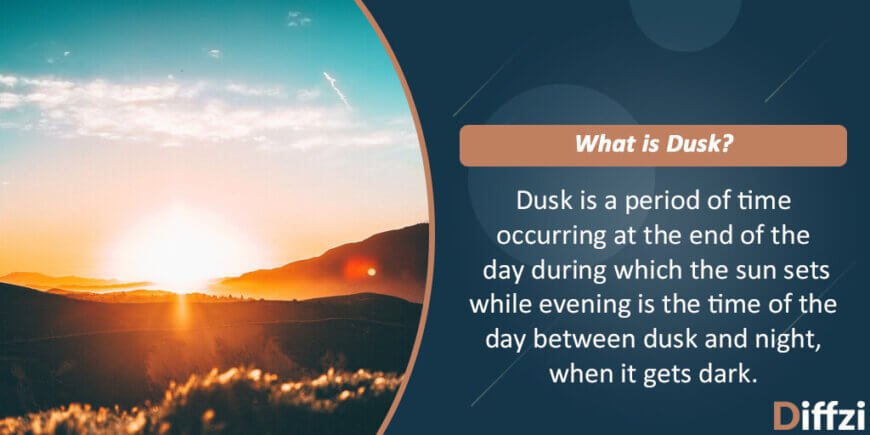The main difference between Dawn and Dusk is that the first one is the limited period of time when the sun is about to rise while the latter one is the limited time of darkness between day and night and therefore are opposite to each other.
Comparison Chart
| Basis | Dawn | Dusk |
| Definition | Limited time of darkness before the sunrise | Limited time of darkness after the sunset |
| Time Period | Between Night and Morning | Between Evening and Night |
| Etymology | “Dagian” which refers to the time when first light falls. | “Dox” which means the time of complete darkness. |
| Activity | Considered as a peaceful time of day | Considered as a busy time of day |
| Literature | Mostly found in autobiographies. | Mostly used in romantic books and novels. |
What is Dawn?
Whenever you wake up early morning, and the sun is about to rise, one is not able to see it but still can witness the redness in the sky, such a time of day is known as Dawn. In simple terms, it can be defined as the date of the day that marks the commencement of the twilight before the rise of the sun. It is also used in a different way when it comes to British English where the beginning of something is known as Dawn.
This word’s origin dates back to the 11th century when it was derived from the term ‘dagian’ which referred to the time of day when the first light falls. It was initially used as Dawning, which is the beginning or first appearance. It is very common in English language and is frequently used. There is no particular time of dawn according to the clock since the timings of sunrise kept on changing depending on the location and based on the date of the year. There are three different types of dawn depending on the systems being followed.
The first one is Astronomical Dawn, which is the time of day when the geometric center of the sun is 18 degrees below the horizon and the before this sky is completely dark. The second type is the Nautical Dawn is the time of day when the sun is 12 degrees below the horizon while Civil Dawn is the time when the sun is 6 degrees below the horizon.

What is Dusk?
After a good sunny day when the sun is about to set, and there is redness in the sky, most of us like to consider that time as the most passive time of the day, this phase exactly is known as Dusk and is the darkest period of twilight. In simple words, it can be defined as the time period which marks the end of the twilight phase after the setting of the sun. This name is originated from old English dialect Dox, which meant darken, it was then refined over the centuries, and Dox became doxian when it mixed with the German language in the middle ages and then finally was known as Dusk in the early 17th century.
It is known as one of the most romantic times of the day and is frequently mentioned in books and movies. Usually confused with the word Twilight it keeps its own identity. Just like Dawn, it also has three different types depending on the movement of the sun. The first one is Astronomical Dusk which occurs when the graphical center of the sun is 18 degrees below the horizon, and the sky becomes completely dark. Interestingly enough it does not have any alternate meanings. Numerical Dusk is the next phase when the sun is 12 degrees below the horizon in the evening while the last one is the Civil Dusk when the center of the sun is 6 degrees below the horizon at the same time.

Key Differences between Dawn and Dusk
- Dawn is known as the morning in simple words while Dusk is known as the evening time.
- The word Dawn is originated from the older English language purely, while Dusk is a mixture of English and German origin.
- Time of day when the first ray of light falls on the earth is known as Dawn while the time when the last rays of sun disappear is known as Dusk.
- Dawn is the peaceful time of the day in comparison while Dusk is relatively busy since most people are awake and active.
- Dawn is considered as more peaceful while Dusk is considered as more romantic in literature terms.
- The word Dawn is mostly found in autobiographies while the world Dusk is mostly found in romantic novels and crime thrillers.